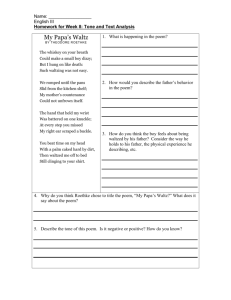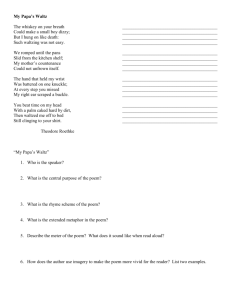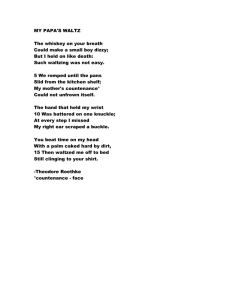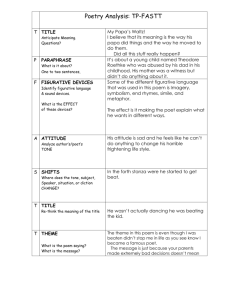Lec #7 Poetry
advertisement
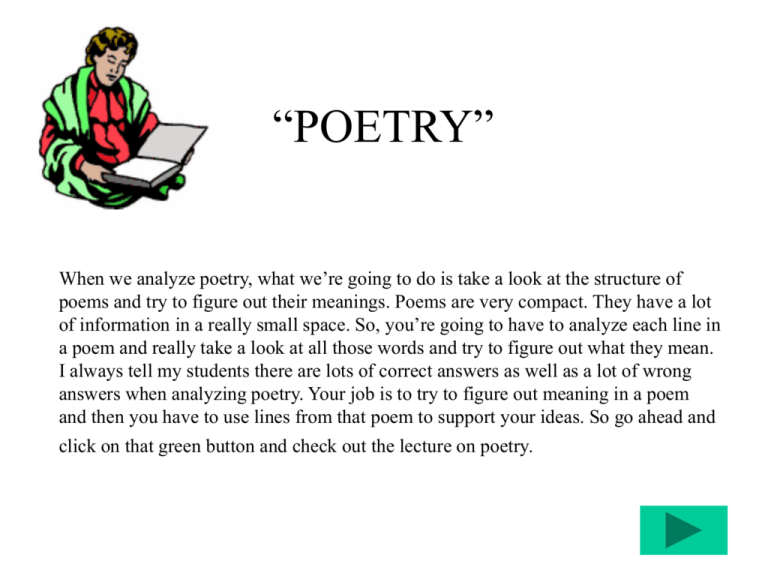
“POETRY” When we analyze poetry, what we’re going to do is take a look at the structure of poems and try to figure out their meanings. Poems are very compact. They have a lot of information in a really small space. So, you’re going to have to analyze each line in a poem and really take a look at all those words and try to figure out what they mean. I always tell my students there are lots of correct answers as well as a lot of wrong answers when analyzing poetry. Your job is to try to figure out meaning in a poem and then you have to use lines from that poem to support your ideas. So go ahead and click on that green button and check out the lecture on poetry. Poem Example – My Papa’s Waltz by Theodore Roethke The whiskey on your breath Could make a small boy dizzy; But I hung on like death: Such waltzing was not easy. We romped until the pans Slid from the kitchen shelf; My mother's countenance Could not unfrown itself. The hand that held my wrist Was battered on one knuckle; At every step you missed My right ear scraped a buckle. You beat time on my head With a palm caked hard by dirt, Then waltzed me off to bed Still clinging to your shirt. Structure of Poetry • Rhyming or Prose [not rhyming]. – When we analyze the structure of a poem, we usually try to find out if it is a rhyming poem where lines rhyme perhaps at the end of the lines or sometimes in the middle. We even have sight rhymes where the words look like they would rhyme on the page even though if we pronounce them, the words don’t rhyme, and then we have prose and what prose essentially means is non-rhyming. – If we take a look at My Papa’s Waltz, we can see that this is a rhyming poem. For example, in the first stanza “the whiskey on you breath / could make a small boy dizzy / but I hung on like death / such waltzing was not easy.” We can see that the second and forth lines rhyme [dizzy / easy]. Structure of Poetry II • Poems are usually broken into sections separated by a space called Stanzas [like a paragraph] - couplet = 2 lines, tercet = 3, quatrain = 4 – My Papa’s Waltz has 4 stanzas and each is made of 4 lines [quatrain] – Why know this structure? • Sometimes the structure leads to a better understanding of the meaning. For example, from My Papa’s Waltz, we can see that every stanza kind of moves a little bit. The first part talks about the whiskey on his breath and hanging on, the next stanza talks about being in the kitchen, the next stanza talks about the dance itself, and finally the last stanza it’s taking him off to bed. So you can see those stanzas are there to break up time and show us movement in the poem. Analyzing Poetry • Speaker – The person speaking in the poem may not be the poet. It may be that the poet has created a persona, or a person in the poem. – In My Papa’s Waltz – the speaker is the little boy now grown up. We know this because it says in the last stanza “you beat time on my head,” my head telling us it’s the speaker who’s the boy. However, the language is not of a small boy but of an adult – so we can figure out the poem is of a memory. • Audience in the poem – There’s often an audience that’s in the poem. For example, the poem may be written to someone specific [not us]. – The audience in My Papa’s Waltz is the father because he says “the whiskey on your breath” [your breath = father’s breath]. Also the title – My Papa’s Waltz. • Audience reading poem – there is the intended audience when poem was written and of course you are the audience too! Words #1 • Tone of voice & Rhythm: – tells us the mood [happy / sad/ angry / excited/ passionate / etc… ] – Tells us the message [how we should feel about the information] – Again in My Papa’s Waltz, if you listen to the poem, “the whiskey on your breath / could make a small boy dizzy / but I hung on like death / such waltzing was not easy.” If you read out loud [and most poems should be read out loud], there’s a rhythm there. A waltz goes 1,2,3,-1,2,3,-1,2,3, and the way the rhythm in the poem is “the whiskey on your breath”, it’s 1,2,3 the same rhythm. It’s very clever, and so we kind of have this waltz rhythm all the way through. Words #2 • Diction: choice of words – If you describe a car crash and you call it an accident that’s a very different image then if I said two cars smashed into one another. • Syntax: order of words – If someone says, “Hi, how are you doing?”, that’s a regular kind of order of words we’re used to, but if the person says, “Doing how are you?” that would kind of surprise us because the order of words were reversed so pay attention when word orders are different, the author is trying to get your attention. • Denotation: literal meaning & Connotation: implied meaning – If I said Mary had a cow and that’s a literal meaning or denotation then Mary is probably a farmer, and she owns a cow. However, connotation is the implied meaning. If I said Mary had a cow, I might mean that she’s really upset - not that she actually owned a cow. – Poets often make use of both literal and implied meanings in poems – in fact, he/she may want us to see both meanings at the same time! Figure of Speech • Simile (like) – she has eyes like blue pools • Metaphor (is/are) – her eyes are blue pools • Personification / anthropomorphism – giving inanimate objects human or living characteristics, so your can say the car purred happily or the door groaned in pain • Allusion (reference to another work, historical event, art, or person to add depth of meaning) – An Allusion can be in the title of the poem or some line in the poem will refer to another work, maybe a piece of art or a person, to add depth of meaning. **It doesn’t mean the poem is about that actual thing!! It means it’s similar. By alluding to that other idea, the poet brings greater depth to the poem. Figures of Speech Cont.. • Metonymy – words based on association – Crown = monarchy [so when we say he took the crown, we don’t mean just took the crown like a thief. We probably mean that he’s taking over the monarchy and that he’s become king.] • Synecdoche – part = whole – Hand = whole person [so when he takes her hand in marriage, he doesn’t just marry her hand, he marries all of her.] • Hyperbole [exaggeration] – I told you a million times to turn down that stereo! • Litote [understatement] – Let’s say I ate 10 candy bars, and someone asks, “Did you eat a lot of chocolate today?” and I reply, “Just a tad.” [opposite of hyperbole] • Paradox and Oxymoron - impossibilities and contradictions – A paradox is two situations that couldn’t possibly occur at the same time [a man could be alive and dead in a poem at the same time]. – An oxymoron combines two contradictory terms like jumbo shrimp. Shrimp means small and jumbo very big, so how you can have jumbo smalls?? Sound • Mood: (flowing, choppy) – We can really get the mood from the way things sound. I remember a line from the Raven, “and the silk and sad uncertain rustling of each purple curtain thrilled me, as I’ve never been thrilled before.” The sound of that can really give us a mood or an idea. • Onomatopoeia: words that sound things they represent – buzz sounds like a bee sound or hiss sounds like the actual cat sound • Alliteration: same consonant at beginning of each word – Little lover lacy • Assonance: same vowel sounds close together – The crook took the book **Poets use these techniques to get the reader’s attention, so a line where you find this is usually important. Rhyme Scheme • • • Often what will happen in a poem is we’ll have very similar rhyme schemes. So if we take a look at My Papa’s Waltz the first stanza, ends on the sounds from breath – “sound A”, the next line dizzy “sound B”, third line ends with death and rhymes with breath so that would be “sound A” again and easy rhymes with dizzy that would be “Sound B” again. So our rhyme scheme would be a, b, a, b. – The whiskey on your breath [sound a] Could make a small boy dizzy; [sound b] But I hung on like death: [sound a] Such waltzing was not easy. [sound b] Rhyme schemes can change - in fact they can be very complicated - you can have abc, abc, you could have a b c b d b, so only every other line rhymes. Rhyme schemes can be really complicated. Take a look at the rhyme scheme, often there will be a change in the poem’s rhyme scheme and that will give us a clue that’s an important line we should take a look at. Impressions • Imagery: sensory impressions – In My Papa’s Waltz, the first stanza “the whisky on your breath could make a small boy dizzy”, we could almost smell that strong alcohol. There’s also sound “we romped until the pans slipped from the kitchen shelf”, so there’s that clattering of the pans coming down. We can see the mother’s frowning, “my mother’s countenance could not unfrown itself.” We can even feel in the poem for example “for every step you missed my right ear scraped a buckle”, so we kind of feel the little boy is kind of getting hurt in all of this dancing. So we want to take a look at those sensory impressions because they’re trying to make an impact on us and make us feel something. • Symbolism: [red rose = love] – In My Papa’s Waltz, the waltz itself is kind of a symbol. It’s a dance. Now a waltz is a very formulated dance, and we can kind of see that this symbol for two people moving around together. However, it’s a little ironic since this dance is not regulated and pans slide from the shelf. So papa is doing a waltz, but not in the right way. So we have a double meaning – like the father is playing with his son which is good, but he’s a bit drunk and rough, so that’s bad. Irony • Verbal irony: (one thing said, another meaning intended) – You could have a man tell a woman, “I love you” but we can’t be sure of the meaning, does he really mean “I love you”, or is he being ironic? Is he saying, “Yeah, I love you” as in of course I DON’T love you, but because we don’t hear tone of voice in poems we have to really look for other clues to let us know what the author means.


